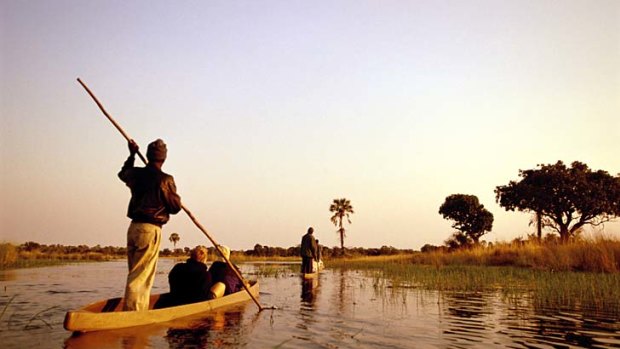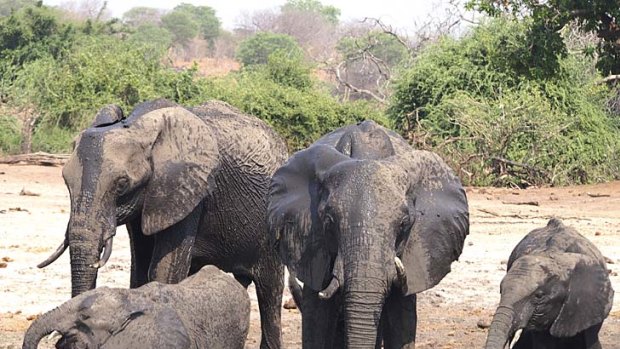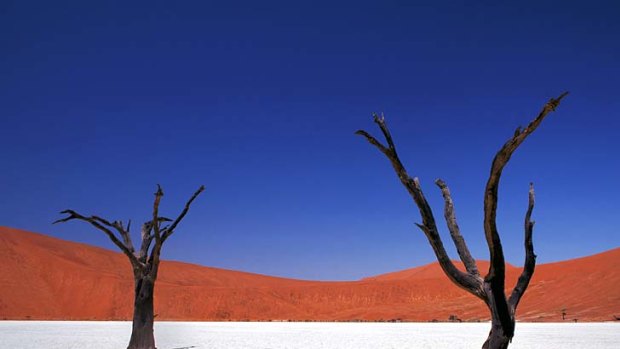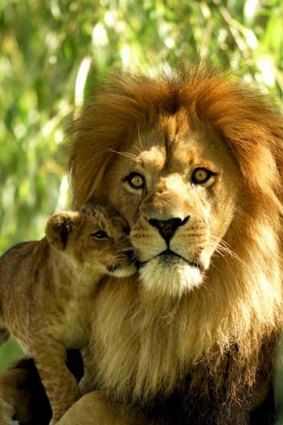
Time stands still ... cruising the backwaters of the Okavango Delta in a makoro.Credit: Getty Images
Diane Armstrong discovers it only takes one lion to find you're never too old for a safari.
As the van bumped and lurched along a road that seemed to be made of corrugated iron, I was bouncing up and down like a bronco rider at a rodeo. It was only the start of my 19-day African tour but already I felt I was getting too old for this kind of trip. It was too long, too hard and too uncomfortable. Although I'd always opted for soft adventure travel and scoffed whenever friends described their indulgent holidays, suddenly five-star resorts and luxury liners seemed very appealing.
But a moment later I almost fell out of the van in excitement. Two massive lions sprawled under a mopane tree were chomping on a warthog, so close that I could see their blood-stained whiskers and hear them crunching the bones. And to add to the thrill, three playful cubs were scampering around them.

An elephant family.Credit: Diane Armstrong
There were six of us Aussies on this Peregrine Adventures tour and, as we drove along the rough sandy track that edged the lush grasses of the savannah in Botswana's Chobe National Park, we kept shouting to our driver, Cosmos, to stop, so we could gaze at all the elephants, zebras, impala and giraffes whose vast numbers were as incredible as their proximity. The animals were so close I could see the long eyelashes of the giraffes and the markings on the ears of the impala.
After the wildlife thrills of Chobe, the Okavango Delta was a complete change of pace and scenery. For two idyllic days we stayed on a houseboat and explored the labyrinth of twisting, reed-fringed waterways that stretched for hundreds of kilometres. Giant crocodiles, whose golden scales glittered in the sun, slithered into the water by day and hippos snorted and grunted outside my cabin by night.
One morning we cruised the shallow backwaters of the delta in traditional dugout canoes called makoros, poled by local youths. For several hours we glided along dreamy channels between the feathery reeds and mauve and white water lilies, while russet jacanas walked on water, and pied kingfishers, fish eagles and red-beaked woodpeckers flew overhead. The only sound I could hear was the splashing of the water and the flapping of bird wings.

Landscapes vary from lush to arid.Credit: Getty Images
Then the channel widened and the boatman pointed. Just ahead of us, a family of hippos were diving and splashing like carefree children. One of them opened its vast mouth so wide that it looked as if it could have swallowed the entire makoro with us inside. Hippos are aggressive and dangerous, so we watched them from a distance, behind tall reeds that concealed our presence. A little later, I heard elephants trumpeting. There were four of them and we came close enough to see white egrets on their backs.
Sunsets on the houseboat were mesmerising. We sat on deck sipping wine as the sun gilded the reeds and trees of the delta. Later, we all sat around the dining table, exchanging travel tales over the tasty meals our friendly skipper prepared. Like Cosmos (and the guide, Innocent), the skipper was also a Zimbabwean and it was fascinating to hear them talk about their country. Cosmos had us spellbound as he described the complex courtship and marriage customs in Zimbabwe. When we told Innocent how simple it was to date and marry girls in Australia, he couldn't believe it. I think he's already applied for a visa.
As we drove towards the Namibian border past traditional villages and bustling little towns with brightly painted cottages, I was sorry to be leaving Botswana. Throughout our visit, I'd been thinking of the heroine of The No.1 Ladies' Detective Agency, and when we entered the immigration office on the border of Namibia, I reckoned I'd finally found her. The immigration officer, in her jangly earrings and bright floral dress, beamed as she shouted, "Damela mma! Damela rra!" and I just knew I'd met a real live Precious Ramotswe. I've never been greeted so exuberantly by an immigration officer.

A resting male lion with cub.Credit: Alamy
Namibia's Etosha National Park is one of the most extraordinary wildlife sanctuaries in Africa, and we spent three thrilling days spotting lions, elephants, giraffes, zebras and wildebeest. During one game drive, we witnessed a drama in the wild. An injured leopard was inching its way towards the carcass of a jackal. But not far away, beneath a stand of mopane trees, two lions were resting. If they saw the vulnerable leopard they'd attack it. I held my breath. Would it reach its prey before the lions pounced? The suspense was unbearable. Finally, with the last of its strength, the leopard grabbed the jackal in its powerful jaws and dragged it safely to its lair.
At Okaukuejo Lodge inside the park, my attractive hut faced the waterhole, and any time of the day or night, I only had to step outside to see a cavalcade of wildlife. One evening a procession of 24 elephants walking single file down the slope to drink. After they'd ambled away, they were followed by rhinos, then giraffes. Then, unbelievably, four lions and three cubs emerged and started lapping the water.
Time and time again, I was convinced that nothing could match the thrill of what we had just seen, and each time I was wrong. After leaving Etosha, we stopped at a beautiful little farm where I hand-fed a cheetah, so close to my favourite animal that I could see the flecks in its amber eyes and count the whiskers on its face.
As we were walking back towards the farmhouse, I did a double take. Walking towards us was a magnificent oryx, a fairytale creature with its long, straight horns. I felt like Alice in a wildlife wonderland.
As we toured Namibia, we passed many villages of traditional round thatched huts, and I often wished we had time to look around, so whenever there was an opportunity to visit a nearby village, I grabbed it. That's how I came to visit Divava. Accompanied by Amos, one of the villagers, I wandered around this impoverished settlement where the locals were sitting outside their thatched huts or squatting on the ground inside their reed-fenced compounds, preparing their dinner.
Amos, who was obviously something of an entrepreneur, was the only one in the village with satellite TV, which he financed by charging his neighbours one dollar to watch international soccer matches.
Throughout the trip, the landscape was magnificent, ranging from soft green grasslands of Botswana's plains and the arid salt pan of Etosha, to the contorted granite monoliths, jagged peaks, and spectacular gorges of Namibia's Damaraland region. Gazing at the dramatic formations in the Fish River Canyon, I felt I was looking at the elemental forces that created our planet.
The scenic wonders of Namibia just kept coming. When we reached Sossusvlei, an area of towering red sand dunes in the Namib Desert, the dawn sun was illuminating one side of the dunes, while casting the other side into shadow, sculpting the steep edge with the sharpness of a chisel.
When Innocent told us that in the desert we'd be staying in a camp, I envisaged a basic tent; instead my accommodation was a spacious hut with a patio that faced a magnificent expanse of grassland and mountains.
Like almost all the lodges we stayed at, this one had a swimming pool, and in the heat of the day it was delightful to have a drink at the bar and then cool down in the pool, which looked out at an untouched panorama of fields and mountains.
Our trip ended in Cape Town. By then, we had driven about 5000 kilometres. Too long? Too hard? No way. I felt elated and privileged to have travelled in such a remarkable part of the world.
The writer travelled courtesy of Peregrine Adventures.
Don't miss
One of the most interesting ethnic groups in Namibia are the Himbas, some of whom I met while at Gelbingen Lodge, our first stop after leaving Etosha National Park. The Himbas, pictured, are a semi-nomadic tribe who count their wealth in cattle. It was astonishing to wander among their mud huts and see women and girls who wore only tiny leather aprons or material loin cloths, and smeared their almost naked bodies and elaborately braided tresses with a thick paste made of red ochre. They let us take their photos as long as we showed them the image and bought some of their jewellery. They've chosen their lifestyle, without running water or electricity, but when I passed the lodge office I noticed one Himba woman charging her mobile phone!
Six tips
1 Have the yellow fever vaccination and bring anti-malarial medication.
2 Take US dollars and South African rand, and change small amounts at a time.
3 Although Botswana and Namibia have their own currency, both accept the South African rand.
4 Avoid travelling October to December, when the heat can be ferocious.
5 Many Africans don't like being photographed, but I found that if you chat to them first, and then ask if it's all right to take their photo, they often agree.
6 Visas are only needed for Zambia and can be bought at the border for $US50 ($50).
Trip notes
Getting there
South African Airways flies to Johannesburg. After an overnight stay at the Emperor Palace Hotel complex near the airport, it's a two-hour flight to Livingstone in Zambia for the start of the tour.
Touring there
The 19-day Peregrine Delta, Dunes, and Falls adventure includes Botswana, Namibia and South Africa. It costs from $6175 a person, twin share. This includes accommodation; transport; sightseeing; game drives and entry fees; a local guide who accompanies the entire tour; all breakfasts and most other meals; and arrival transfer. The maximum number in the group is 15. It has regular departures, year-round, operating in both directions between Livingstone and Cape Town.
More information
1300 854 500, peregrineadventures.com.
Sign up for the Traveller Deals newsletter
Get exclusive travel deals delivered straight to your inbox. Sign up now.